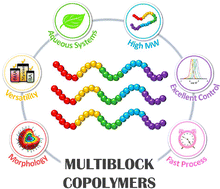A multiblock copolymer is a polymer of a specific structure that consists of multiple covalently linked segments, each comprising a different monomer type. The control of the monomer sequence has often been described as the “holy grail” of synthetic polymer chemistry, with the ultimate goal being synthetic access to polymers of a “perfect” structure, where each monomeric building block is placed at a desired position along the polymer chain. Given that polymer properties are intimately linked to the microstructure and monomer distribution along the constituent chains, it goes without saying that there exist seemingly endless opportunities in terms of fine-tuning the properties of such materials by careful consideration of the length of each block, the number and order of blocks, and the inclusion of monomers with specific functional groups. The area of multiblock copolymer synthesis remains relatively unexplored, in particular with regard to structure–property relationships, and there are currently significant opportunities for the design and synthesis of advanced materials. The present review focuses on the synthesis of multiblock copolymers via reversible addition–fragmentation chain transfer (RAFT) polymerization implemented as aqueous emulsion polymerization. RAFT emulsion polymerization offers intriguing opportunities not only for the advanced synthesis of multiblock copolymers, but also provides access to polymeric nanoparticles of specific morphologies. Precise multiblock copolymer synthesis coupled with self-assembly offers material morphology control on length scales ranging from a few nanometers to a micrometer. It is imperative that polymer chemists interact with physicists and material scientists to maximize the impact of these materials of the future.
